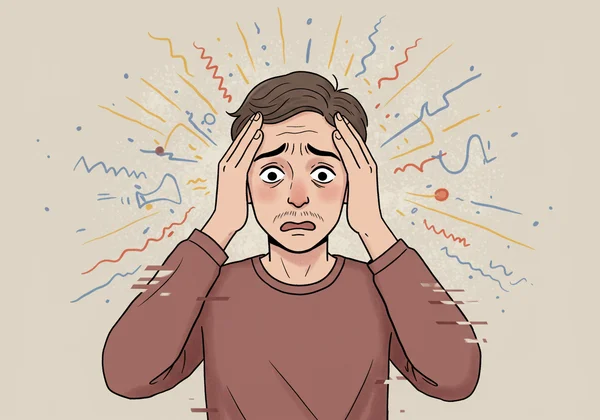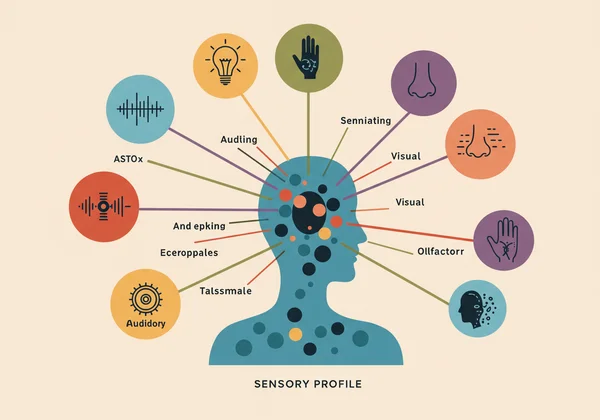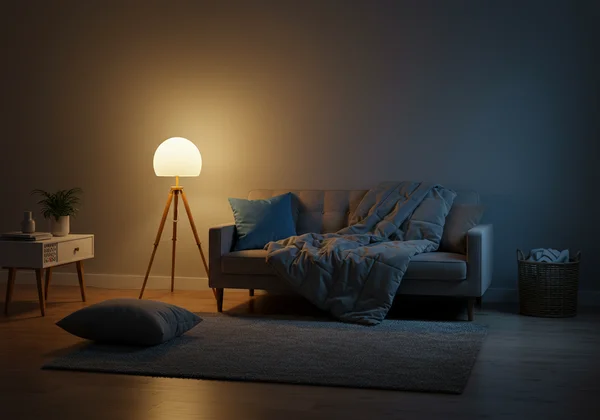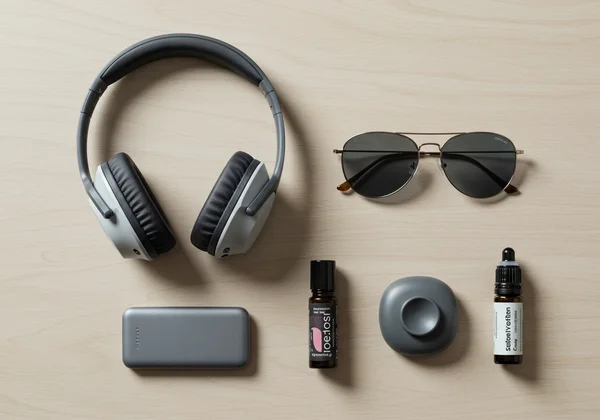Aspie Quiz Insights: Managing Sensory Overload as a Neurodivergent Adult
Does the world ever feel too loud, too bright, or simply "too much"? If the hum of a refrigerator sounds like a siren or the texture of a sweater feels like sandpaper, you are not alone. This experience is often called sensory overload, and it's a common reality for many neurodivergent adults. The good news is that there are effective sensory overload strategies to help you navigate the world with greater comfort and confidence. What is sensory overload and how can it be managed?

This guide offers seven practical strategies to help you understand your sensory needs and build a life that honors them. It’s about making exploration easier so you can make life richer. If you're starting this journey of self-discovery, you can explore your traits with a supportive online tool designed to provide clarity.
Understanding Your Sensory Landscape: Identifying Triggers
The first step in coping with sensory issues is understanding your unique sensory profile. Everyone processes sensory information differently. For neurodivergent individuals, this processing can be more intense, leading to feelings of being overwhelmed, anxious, or exhausted by everyday environments. This isn't a flaw; it's a fundamental difference in wiring.
Recognizing what triggers your sensory overload is an act of empowerment. It shifts the focus from merely reacting to overwhelm to proactively managing your environment and well-being. This self-awareness is the foundation upon which all other strategies are built.
Common Sensory Overload Triggers: Light, Sound, Touch, and More
While your experience is personal, there are common sensory triggers that affect many neurodivergent people. Pinpointing them is like drawing a map of your sensory world.
- Auditory: Loud, sudden noises (sirens, alarms), overlapping conversations in a crowded room, persistent background sounds (fans, fluorescent light hums).
- Visual: Bright or flickering lights, intense colors, cluttered spaces, or overwhelming patterns.
- Tactile: Unexpected touch, certain fabric textures (like wool or stiff tags), or the feeling of specific foods.
- Olfactory (Smell): Strong perfumes, cleaning products, or food smells.
- Vestibular & Proprioceptive: Feeling off-balance, crowds that jostle you, or activities that involve unexpected movements.
Tracking Your Unique Sensory Patterns and Responses
To truly understand your triggers, consider keeping a simple journal for a week or two. Note when you feel overwhelmed, anxious, or need to withdraw. What was happening around you? What sounds did you hear? What were you seeing or feeling? Over time, you'll begin to see your unique patterns emerge. This process of discovery is a powerful part of understanding your neurotype, and a neurodivergent self test can offer further insights into your personal traits.

Creating Your Sensory-Friendly Sanctuary
Your environment plays a massive role in your sensory well-being. By making conscious changes to your personal spaces, you can create a sanctuary that recharges you rather than drains you. This is about taking control and designing a world that works for you. These modifications are key components of effective sensory sensitivities autism management.
Designing Your Home: From Lighting to Texture
Your home should be your ultimate calming space. Consider making small adjustments that can have a big impact.
-
Lighting: Swap harsh fluorescent bulbs for warm, incandescent or LED lights. Use dimmer switches to adjust brightness throughout the day. Blackout curtains can be a lifesaver in bedrooms.
-
Sound: Use rugs and soft furnishings to absorb ambient noise. Consider a white noise machine to mask jarring background sounds.
-
Texture: Fill your space with textures you love, like a soft weighted blanket, smooth cushions, or a comfortable rug. Organize and declutter to create a visually calm environment.

Navigating the Outside World with Portable Sensory Tools
You can’t control every environment, but you can bring tools with you to help manage unexpected neurodivergent sensory input. Creating a portable sensory kit puts you back in the driver's seat.
Your kit might include:
-
Noise-canceling headphones or earplugs: To dampen overwhelming soundscapes.
-
Sunglasses or a wide-brimmed hat: To reduce visual strain from bright lights.
-
Fidget tools: A small, quiet item to channel anxious energy and help you focus.
-
A calming scent: A small vial of a comforting essential oil, like lavender.

Taking these steps helps you start your journey toward a more comfortable existence, both at home and out in the world.
Proactive & Reactive Strategies for Sensory Management
Effective management involves both planning ahead (proactive strategies) and knowing what to do in the moment (reactive strategies). By combining these approaches, you create a robust system for navigating sensory challenges. This two-pronged approach is one of the most effective sensory overload strategies available.
When You Feel It Coming: Pre-emptive Measures
Meltdown prevention is about recognizing the early warning signs of overload and taking action before you're completely overwhelmed.
- Plan Ahead: Before going to a new place, look up pictures online to get a sense of the visual environment. If going to a social event, plan to arrive early before it gets crowded or identify a quiet space where you can retreat.
- Schedule Downtime: Don't pack your schedule. After a stimulating activity, plan for quiet, restorative time alone to decompress and allow your nervous system to regulate. This is non-negotiable self-care.
- Energy Budgeting: Think of your sensory capacity as a daily budget. Some activities cost more than others. A crowded supermarket trip might use up most of your budget, meaning you'll need a quiet evening to recover.
In the Moment: Grounding & Calming Techniques
When you feel overload setting in despite your best efforts, having grounding techniques ready can help you regain a sense of control.
- The 5-4-3-2-1 Method: Look around and name 5 things you can see, 4 things you can feel, 3 things you can hear, 2 things you can smell, and 1 thing you can taste. This pulls your focus away from the overwhelming input and into the present moment.
- Deep Breathing: Focus on slow, deep breaths. Inhale for four counts, hold for four, and exhale for six. This helps calm your physiological stress response.
- Apply Deep Pressure: If possible, wrap yourself in a blanket, use a weighted lap pad, or simply hug yourself firmly. Deep pressure has a calming effect on the nervous system. If you're curious about how your traits connect to these needs, a free aspie quiz can provide valuable starting points.
Advocating for Your Sensory Needs and Setting Boundaries
Perhaps the most powerful strategy is learning to communicate your needs to others. This isn't being difficult; it's a form of self-respect. Clear communication and firm setting boundaries are essential for long-term well-being and managing neurodivergent sensory input.
Explain your needs simply and directly. For example:
- "The music in here is a bit too loud for me. Would it be okay if we moved to a quieter table?"
- "I need a few minutes of quiet time to recharge before our next activity."
- "I find fluorescent lights very draining. Could we use the lamp instead during our meeting?"
Learning to advocate for yourself can feel challenging at first, but it is a vital skill. Understanding your own needs is the first step, and resources that offer deeper insights into your personality profile can build the confidence needed for effective self-advocacy.
Disclaimer: This article is for informational purposes only. The strategies discussed are intended to support well-being and are not a substitute for professional medical advice, diagnosis, or treatment. The online tools mentioned, including the Aspie Quiz, are for self-exploration and are not a clinical diagnosis.
Your Questions About Sensory Overload Answered
Is sensory overload common in neurodivergent individuals like those with Asperger's?
Yes, it is very common. Many neurodivergent people, including those on the autism spectrum, process sensory information differently and often more intensely than neurotypical individuals. This heightened sensitivity can make them more susceptible to becoming overwhelmed by stimuli that others might not even notice.
How can the Aspie Quiz help me understand my sensory traits?
The Aspie Quiz includes questions that explore various traits associated with the autism spectrum, including sensory sensitivities. Your results can provide a structured overview of your neurodivergent and neurotypical traits, offering a data point for your sensory profile. The optional AI-powered report can offer even more personalized insights into how these traits, including sensory issues, might manifest in your daily life.
Can persistent sensory overload lead to autistic burnout?
Absolutely. Autistic burnout is a state of profound physical, mental, and emotional exhaustion often caused by the cumulative effect of navigating a world not designed for your neurotype. Chronic sensory overload is a major contributor, as it constantly drains your energy reserves. Managing sensory input proactively is a key strategy for preventing burnout.
When should I seek professional help for severe sensory issues?
If your sensory sensitivities are causing significant distress, interfering with your ability to work or maintain relationships, or leading to severe anxiety or meltdowns, it's a good idea to seek professional help. An occupational therapist specializing in sensory integration or a therapist knowledgeable about neurodiversity can provide tailored strategies and support. Taking the first step to begin your self-discovery can be a helpful foundation for these conversations.
Embracing Your Sensory Profile: A Path to Richer Living
Managing sensory overload isn't about hiding from the world. It’s about understanding yourself more deeply and building a life that honors your unique nervous system. By identifying your triggers, creating supportive environments, using practical strategies, and advocating for your needs, you can reduce overwhelm and free up energy for the things you truly love.
This journey of self-exploration is a path to a richer, more authentic life. If you’re ready to learn more about your unique traits, take the aspie quiz and continue your journey of discovery today. Your sensory world doesn't have to be a battleground; it can be a place you understand and navigate with confidence.